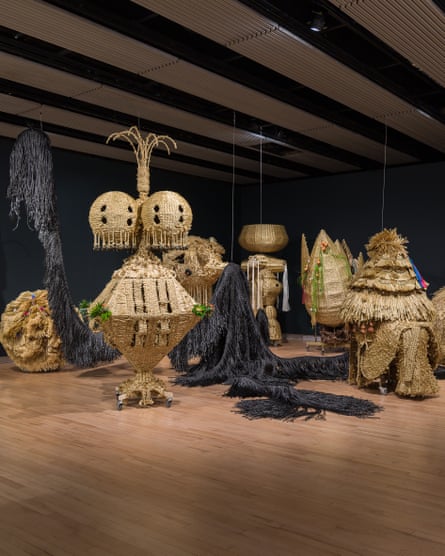When Haegue Yang was in Germany a few years ago, she became fascinated by a local hardware store, or more specifically its catalogue. She made a series of collages by cutting it up, including one in which rolls of brown packing paper are arranged in a star-like symmetrical pattern. And that’s it. The Hayward’s retrospective of this 53-year-old South Korean is full of stuff like this. It is immense, crowded and completely unrewarding. None of it adds up and none of it is moving – unless you are the kind of person who tears up over a venetian blind. “Venetian blinds are a prominent feature,” says a wall text, explaining Yang’s work. “She is particularly drawn to their tilted slats.”

In one installation, these tilted slats cover the sides of illuminated boxes. It comes as a shock when you read that this neutral-looking work is entitled 5, Rue Saint-Benoit and is meant to suggest the Paris home of the novelist Marguerite Duras where she lived as a member of the resistance in the second world war. Looking again, you see that one of the blinded crates is painted like a tricolour. Otherwise, the heavy cultural reference hangs irrelevantly in the void – and it’s not the only one.
In a new commission, lights play on an array of venetian blinds that recede like scenery in a toy theatre, choreographed to the Korean composer Isang Yun’s Double Concerto for Oboe and Harp With Small Orchestra. Elsewhere, notes on metal boards muse on Primo Levi and the Holocaust, George Orwell shooting an elephant and Edward Said on Palestine, but chopped up and moved about until any meaning is lost.
Presumably that’s the point: that big ideas, grand narratives, any kind of sense at all can’t stand up to the onrush of information and global complexity of our world right now. You come into the show and it’s as crazy as a megacity. Traditional bells are dingling, sculptures rushing about – or at least rolling around as they are pushed on casters by specialist sculpture-pushers. These sculptures are colourful, complicated blobs of matting that sprout pointy nodes, tendrils and flowers, moving over a precisely marked-out, abstract floor drawing. What’s this all about? Search me.
Or rather, at one level, it’s very easy to say what it’s all about: the Crazy Complexity of Our World. Or, as the Hayward has it, the “hybridity” and “interconnectivity” of contemporary life. The trouble is, to say we live in a richly layered interconnected reality is just a fact. We all know this. Yang’s art doesn’t evoke much beyond the chaos and fun we experience when we go down the shops.

She makes a lot of use of collage, the technique invented by Picasso and developed by the dadaists to suggest the fragmentation of modern life. But there’s no dirt in her collages, no wildness or randomness to shock you or make you anxious. They are neatly stylish. One series uses cut-up envelopes to create shapes that are rounded at one end and sharp at the other. They’re shown over a wall-sized, black and white photograph of a sunny suburban landscape snappily called Poetics of Displacement.
With such a grand, important title it’s easy to interpret, yet hard to be bothered about. The cutout comets of course represent peoples’ global mobility, the photo speaks (or rather its title does – the picture itself says nothing) of “Displacement”, just as the sculptures on wheels suggest our many migrations. In another gallery, there’s an installation called Storage Piece, in which her belongings are packed away in boxes. It’s not an emotive story of modern life, just a dull-as-dishwater image of something universal today. When you depict the modern world this coolly and conceptually, who cares?

Yang does give hints of her own life. Much is made of her first exhibition, which she staged in her grandparents’ empty old home. Perhaps you had to be there. But as commemorated here, it just looks like some nice lights in a decayed house. The curators clearly think they are telling the story of a great artist, but I can see nothing to justify that reverence.
A lot of Yang’s work, in fact, is pretty. So the best way to enjoy the show is probably as cool ideas for decoration. Under all the guff about interconnectivity, all the quotes from Levi and Orwell, a very gentle artist is struggling to get out. You realise this when you reach the vegetable prints. When she is at her least pretentious, Yang enjoys making pale-coloured patterns of imprinted leaves and everyday veg. They look nice, if a bit bland. She also makes bright paper cutouts that she calls Mesmerising Mesh, with intersecting patterns of triangles, masks and biomorphic shapes. Again they are attractive, but lack weight or depth.
This art says nothing to me. Not once does it express human pain or longing, or touch on the mystery of existence, or make you look a reality in the face – it’s just playing games with itself, ironically juxtaposing Korean tradition and modern banality without a shred of poetry. All I can hear is my inner voice saying: “Pull the other one – it’s got jangly little bells on it.”
